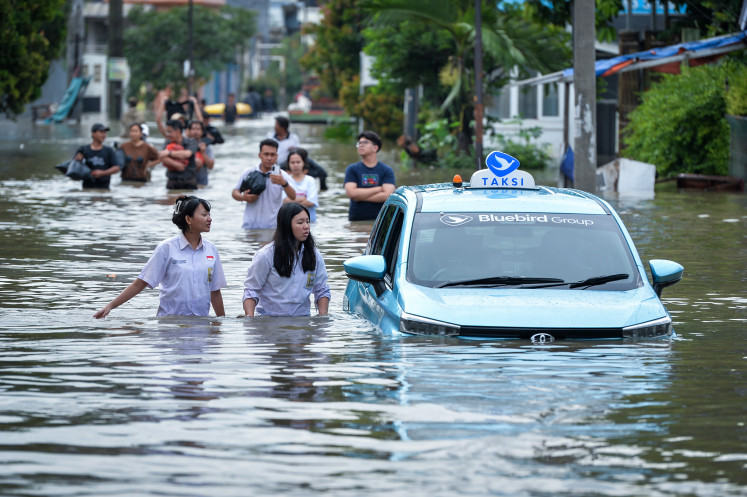Popular Reads
Top Results
Can't find what you're looking for?
View all search resultsPopular Reads
Top Results
Can't find what you're looking for?
View all search resultsGlobal warming and the threat to sovereignty
Global Warming (GW) is one of today's most popular issues and the United Nations Framework Conference on Climate Change held in Bali last year was an example of how seriously the matter is being taken
Change text size
Gift Premium Articles
to Anyone
Global Warming (GW) is one of today's most popular issues and the United Nations Framework Conference on Climate Change held in Bali last year was an example of how seriously the matter is being taken.
GW has many impacts, including on sovereignty, especially when it causes sea-levels to encroach on small islands, maritime jurisdictions and international maritime boundaries.
Indonesia is an archipelagic state with more than 17,000 islands. According to Presidential Regulation no. 78/2005, of those islands 92 are considered small. These small islands include several outlying islands that offer Indonesia strategic value.
These outlying islands are used as reference points for defining various maritime jurisdictions, including territorial seas, contiguous zones, exclusive economic zones and continental shelves.
The islands also serve to demarcate maritime boundaries shared with ten neighboring states: India, Thailand, Malaysia, Singapore, Vietnam, Philippines, Palau, Papua New Guinea, Australia and Timor Leste.
The UN revealed that during the 20th century, global temperatures increased by up to 0.740 degrees Celsius. If carbon dioxide concentrations reach 550 parts per million, temperatures will likely increase on average by 2-4.50 Celsius, resulting in an average global temperature of 30 Celsius.
Also to consider are the effects of the melting polar ice caps which, during the 20th Century, led to a 17 cm rise in sea-levels. It has been predicted sea-levels will rise in the range of 28-58 cm throughout the 21st century (UN, 2007).
One of the impacts of this is the submergence of small islands or low-land areas. Low-lying South Pacific nations, such as Kiribati and Vanuatu, for example, are sinking beneath the waves.
While this may seem disastrous, Indonesia is predicted to lose around 2,000 islands by 2030 due to GW. This prediction has been affirmed by Prof. Indroyono Susilo of the Ministry of Marine Affairs and Fisheries (Kompas.com, Feb. 27, 2008) and the head of Yogyakarta Bureau of Meteorology and Geophysics (MBG) (Antara, May 23, 2007).
Murjaya stated sea levels could increase by up to 29 cm before 2030. At least 2,000 islands in Indonesia are less then 29 cm in height.
Even though the number of endangered islands cannot be easily estimated, the potential of their loss is obvious.
The submergence of small outlying islands will result in lost reference points, thus influencing the status and extent of Indonesia's maritime area. This, therefore, is a serious issue that could threaten sovereignty and sovereign rights.
Although we should be aware of GW and its effects, certain areas must be defined to avoid misunderstanding. For example, an island must be universally defined according to the United Nations Convention on the Law of the Sea article 121, which states that an island is naturally formed, surrounded by water, and above sea level during high tide.
The last criterion, which depends on sea tide observations, concerns geodesy and hydrography. Without precise data on sea tides and island heights in Indonesia, we cannot determine the numbers of islands sinking due to GW. It is even difficult to discern which objects are islands and which are not.
So what does GW have to do with international maritime borders? Changes in sea-levels can alter coast-lines and the maritime boundaries they define.
As an archipelagic nation, Indonesia is threatened by GW and authorities need to take preventative action to protect its borders.
The question is: how can we fight GW? Can this global phenomenon be influenced on an individual level?
While cutting down on energy-use seems the most obvious solution, this measure lies not in the power of ordinary people, but in the hands of those few in positions of power in our society.
However, the small things we can do will still have an impact. Taufik Ismail wrote that we might not be able to be banyan trees, but we could be bushes around a lake. We can also be grass, which may neither be strong or tall, but still serves to strengthen river banks.
What small thing have you done to fight GW today?
The writer is lecturer of the Department of Geodetic Engineering at Gadjah Mada University, and a United Nations researcher of ocean affairs and the law of the sea (2007).










